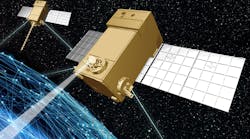Lockheed Martin has been awarded a Tranche 0 contract of the Space Transport Layer from the Space Development Agency (SDA) to demonstrate a mesh network of 10 small low-Earth-orbit satellites (LEOS). The network, which is to be launched in just two years, will link different terrestrial warfighting systems and their users with space sensors for enhanced beyond line-of-sight (LOS) awareness for the warfighters.
The $187.5-million contract, from the SDA, is for the test and demonstration of the satellites and the communications network they form, with a total of 20 satellites to be launched by two defense contractors including Lockheed Martin. By linking warfighters using different system domains, the satellite networks will enable Joint All-Domain Operations. “We see a world across all warfighting domains where fourth- and fifth-generation fighters and tactical forces on the ground can connect seamlessly with holistic situational awareness,” said Kay Sears, vice-president and general manager of Lockheed Martin Military Space. “Interoperability and battlespace connectivity are critical to staying ahead of our adversaries.”
The 10 LEOS being launched by Lockheed Martin (see the figure) will provide wide-bandwidth, low-latency data communications links and will introduce Link 16 network capability to space. Such communications capabilities will connect a wide range of electronic defense systems, including for F-16, F-22, and F-35 fighter aircraft, missile defense networks like PAC-3 and THAAD missile defense networks, and Integrated Air and Missile Defense (IAMD) networks. The data links will provide sensor-to-shooter targeting and situational awareness for tactical land and maritime warfighters. In addition, the satellites will provide interoperability with both military-protected and commercial satellite-communications (satcom) systems. The 10 LEOS will be programmable via Lockheed Martin’s SmartSat software and cyber-hardened by means of Lockheed Martin’s Cyber Resiliency Level model.
